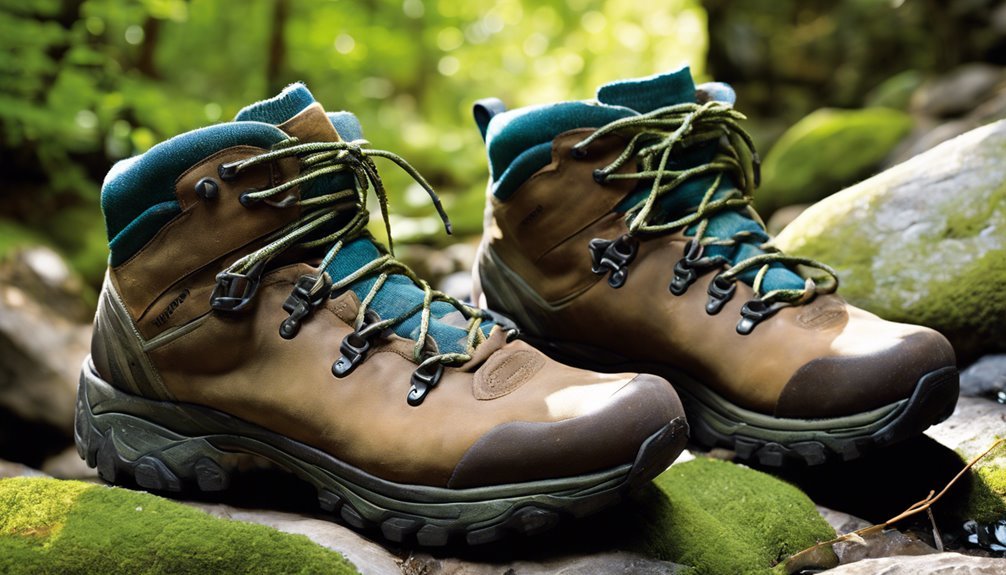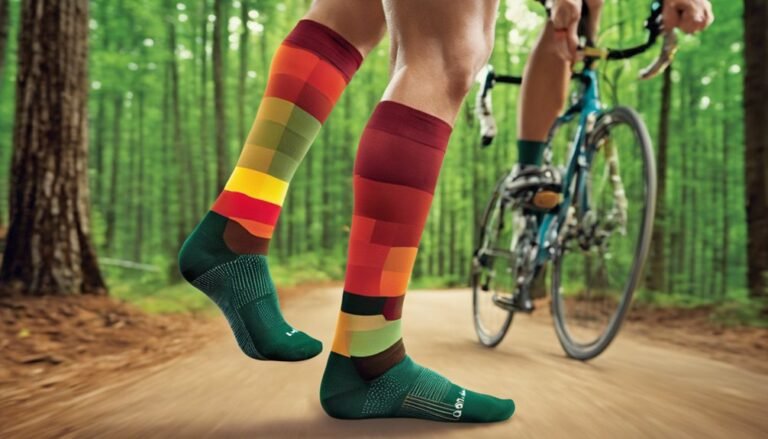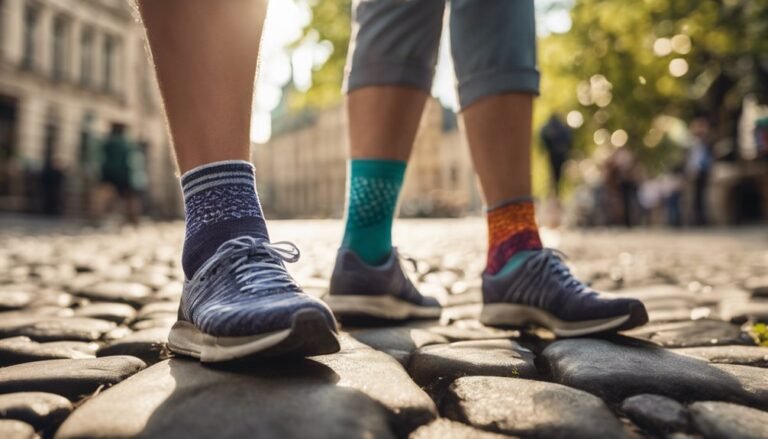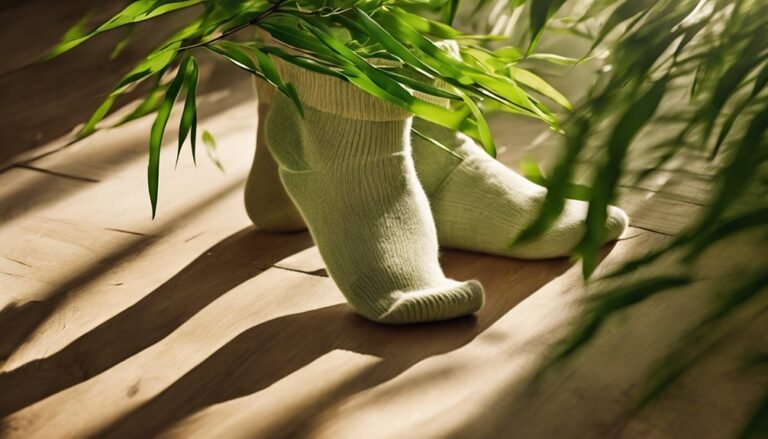Best Hiking Socks to Keep Your Feet Dry & Blister-Free
Imagine this: You're halfway up a challenging mountain trail, the sun is shining, the air is crisp, and every step you take feels like a victory.
But then, discomfort begins to creep in, starting with a slight irritation at the back of your heel. Suddenly, your hiking adventure is overshadowed by the threat of a blister forming.
Have you ever noticed how such a small issue can derail an entire experience?
To keep your feet dry and blister-free on hikes, consider opting for hiking socks made from a blend of merino wool and synthetic fibers.
Look for seamless designs to reduce friction and reinforced heel and toe areas for added durability.
Guarantee a snug fit and consider moisture-wicking technologies to keep your feet feeling fresh.
The right socks will cushion, regulate temperature, and prevent blisters.
Selecting wisely will enhance your comfort and performance, revealing more insights to optimize your hiking adventures.
Understanding the Importance of Hiking Socks

When you're gearing up for a hike, it might be tempting to focus solely on boots, but don't underestimate the importance of a good pair of hiking socks. The right sock fit guarantees your feet stay comfortable and supported throughout your trek. A snug but not tight fit can prevent blisters and slippage, giving you the freedom to enjoy every step without discomfort. Consider sock length as well, as it should complement your hiking boots. Longer socks can offer extra protection against debris and chafing, while shorter ones might be preferable in warmer weather for breathability. Choosing the ideal hiking socks is about enhancing your overall experience, allowing you to embrace the trail ahead with confidence and ease.
Key Features to Look for in Hiking Socks
While starting your hiking adventures, you'll soon realize that not all socks are created equal, and choosing the right features can make a significant difference. One important element is sock thickness. Thicker socks offer better cushioning and warmth, ideal for rugged trails or colder climates. However, if you're trekking in warmer weather, a lighter sock might be more comfortable. Ankle height is another key consideration. Low-cut socks work well for casual hikes or when wearing low-top shoes. In contrast, mid or high-ankle socks provide added protection against debris and support for your ankles on uneven terrain. Don't overlook reinforced heel and toe areas for durability. Prioritizing these features lets you tailor your socks to match the demands of your journey, enhancing your hiking freedom.
Top Materials for Moisture-Wicking Performance

Moisture management is crucial for maintaining comfort and preventing blisters during hikes, making the choice of sock material essential. When seeking the best materials, consider merino wool's advantages. This natural fiber excels in regulating temperature, keeping your feet warm in cold conditions and cool when it's hot. It naturally wicks moisture, reducing the risk of blisters. Plus, merino wool is odor-resistant, which means you can enjoy multi-day hikes with confidence.
On the other hand, synthetic fibers like polyester and nylon offer excellent moisture-wicking capabilities and dry faster than natural fibers. They're typically more durable and affordable, providing a practical option for those who value performance and budget. Weighing merino wool against synthetic options enables you to find the perfect balance for your hiking needs.
Best Seamless Design Options for Comfort
In your quest for the ultimate hiking socks, seamless design options are pivotal for ensuring maximum comfort on the trail. Seamless construction benefits you by eliminating those pesky pressure points and friction areas that often lead to blisters. This design innovation allows your feet to move freely and comfortably, enhancing your overall hiking experience. When comparing comfort levels, seamless socks stand out, offering a smooth, irritation-free fit. They mold to your feet, reducing bulk and ensuring a snug embrace without constriction. You'll find that these socks provide a liberating sense of mobility and ease, perfect for those who crave unhindered exploration. With seamless socks, you're not just hiking; you're commencing on a journey with comfort as your steadfast companion.
Exploring Cushioning Levels for Different Terrains

As you embrace the seamless comfort of your hiking socks, the next consideration is understanding how cushioning levels cater to different terrains. When you're venturing into the wilderness, cushioning benefits can make or break your experience. For rocky trails, opt for socks with extra padding to absorb shock and protect your feet from uneven surfaces. On sandy or softer paths, a medium cushion provides the perfect balance, offering flexibility without sacrificing support. If you're tackling steep inclines or declines, maximum cushioning guarantees your feet stay blister-free, allowing you to explore freely. Tailoring your sock's cushioning to the terrain's demands not only enhances comfort but also boosts endurance, enabling you to conquer any landscape with confidence and freedom.
Top Picks for Cold Weather Hiking Socks
When you're heading out on a chilly hiking adventure, selecting the right socks makes all the difference in keeping your feet warm and dry. Look for options featuring advanced insulating materials like merino wool, which provide excellent warmth without bulk, combined with moisture-wicking technologies that prevent dampness from slowing you down. Additionally, the thermal cushioning benefits found in these top picks will guarantee comfort and protection against the cold, so you can focus on the trail ahead.
Insulating Material Choices
Although the thrill of hiking in cold weather is undeniable, ensuring your feet stay warm and comfortable is essential for an enjoyable experience. Exploring insulating materials for hiking socks reveals a fascinating array of options. Wool is a classic choice, known for its natural warmth and comfort, but wool alternatives shouldn't be overlooked. Synthetic blends, for instance, offer impressive insulation while being lighter and more durable. These blends often incorporate materials like polyester and nylon, which enhance the sock's ability to trap heat without adding bulk. This means you can embrace the rugged freedom of the trail without the weight of heavy socks. Selecting the right insulating material can make all the difference, letting you roam the winter wilderness with ease.
Moisture-Wicking Technologies
While choosing the right insulating material keeps your feet warm, managing moisture is just as important for comfort during cold weather hikes. Moisture-wicking technologies in sock construction guarantee your feet remain dry and blister-free. These advanced materials pull sweat away, enhancing moisture management and preventing the dreaded chill of damp socks.
Imagine the freedom of hiking in any weather without discomfort:
| Feeling | Benefits |
|---|---|
| Dry | No blisters |
| Warm | Increased comfort |
| Free | Endless adventures |
Consider socks featuring merino wool or synthetic blends, each designed to optimize moisture transfer. You'll find that innovative weaves and breathable fabrics contribute to a seamless hiking experience. Choose wisely—your feet deserve the best, embracing the liberty to explore without limits.
Thermal Cushioning Benefits
To maximize comfort and warmth on cold weather hikes, understanding the benefits of thermal cushioning in hiking socks is essential. When you're traversing chilly terrains, thermal insulation in your socks acts as a barrier against cold, keeping your feet toasty. The right cushioning materials, like merino wool or synthetic blends, offer not just warmth, but a plush feel that absorbs impact and reduces fatigue.
Imagine the freedom of exploring frosty landscapes without the worry of numb toes. It's not just about warmth—cushioned socks provide extra support for your arches, enhancing balance and stability. As you hike, the layers of thermal insulation also wick moisture away, preventing blisters. Choose socks with these features, and let your adventurous spirit roam unencumbered by the cold.
Lightweight Hiking Socks for Hot Weather Adventures
When commencing on a hot weather adventure, it is vital to select the right gear, starting with lightweight hiking socks. Opt for socks crafted from breathable fabrics like merino wool or synthetic blends, which excel in moisture-wicking properties. Lightweight designs guarantee your feet remain cool and comfortable, allowing you to roam freely and fully embrace the journey. These socks provide the perfect balance between durability and breathability, significant for long hikes under the sun's relentless heat.
With their quick-drying capabilities, you won't have to worry about sweaty, uncomfortable feet hindering your expedition. Prioritizing high-quality materials guarantees that your feet stay dry and fresh, giving you the freedom to explore trails without restraint. Choose wisely, and let your feet lead the way to new horizons.
Best Hiking Socks for Preventing Blisters
Selecting the right hiking gear doesn't stop at keeping your feet cool; it's equally important to protect them from blisters. Blister prevention starts with understanding that sock fit is essential. You want a pair that hugs your feet snugly without being too tight—this reduces friction, the main culprit behind blisters. Look for socks designed with seamless construction and cushioned areas, as these features minimize irritation during your trek. Opt for materials like merino wool, which wick moisture away while offering unparalleled comfort. Consider double-layered socks, as they provide an extra barrier against blister-causing friction. Remember, the best hiking socks for blister prevention empower you to roam freely, ensuring your feet remain as adventurous as your spirit.
Care and Maintenance Tips for Long-Lasting Hiking Socks
While the right pair of hiking socks can greatly enhance your trail experience, their longevity depends heavily on proper care and maintenance. To guarantee your socks stay in peak condition, focus on sock washing and sock storage. Here's how:
- Gentle Washing: Wash your socks inside out in cold water using a mild detergent. This prevents fabric damage and color fading.
- Air Drying: Skip the dryer. Instead, lay your socks flat to dry. This preserves elasticity and prevents shrinkage.
- Proper Storage: Store socks in a cool, dry place, ensuring they're completely dry to avoid mildew or odor.
Caring for your hiking socks not only prolongs their lifespan but also keeps your feet happy and free, ready for your next adventure.
Frequently Asked Questions
How Do I Choose the Right Size Hiking Socks?
Choose hiking socks by measuring your foot size, considering sock materials for durability, and sock thickness for comfort. Guarantee a snug fit without tightness. Remember, freedom on trails starts with the right fit and comfortable feet.
Can Hiking Socks Be Worn With Any Type of Shoe?
Think of hiking socks as chameleons, blending with any shoe type. Whether it's boots or sneakers, sock materials like merino wool guarantee shoe compatibility. Feel the freedom to explore without compromising comfort or style on your journey.
Do Hiking Socks Need to Be Broken in Before Long Hikes?
You don't need to break in hiking socks before long hikes. Instead, focus on choosing high-quality sock materials like merino wool or synthetic blends, which offer blister prevention and guarantee comfort and freedom on your adventures.
Are There Eco-Friendly Hiking Sock Options Available?
Imagine trekking through lush forests, your feet embraced by socks crafted from sustainable materials. Yes, you'll find eco-friendly options that combine ethical production with comfort, ensuring your adventures tread lightly on the Earth while granting you freedom.
How Often Should Hiking Socks Be Replaced?
To guarantee sock longevity, replace hiking socks every six months with regular use. Maintain them by washing gently, air-drying, and avoiding fabric softeners. Prioritizing sock maintenance gives you the freedom to explore without discomfort or restrictions.







